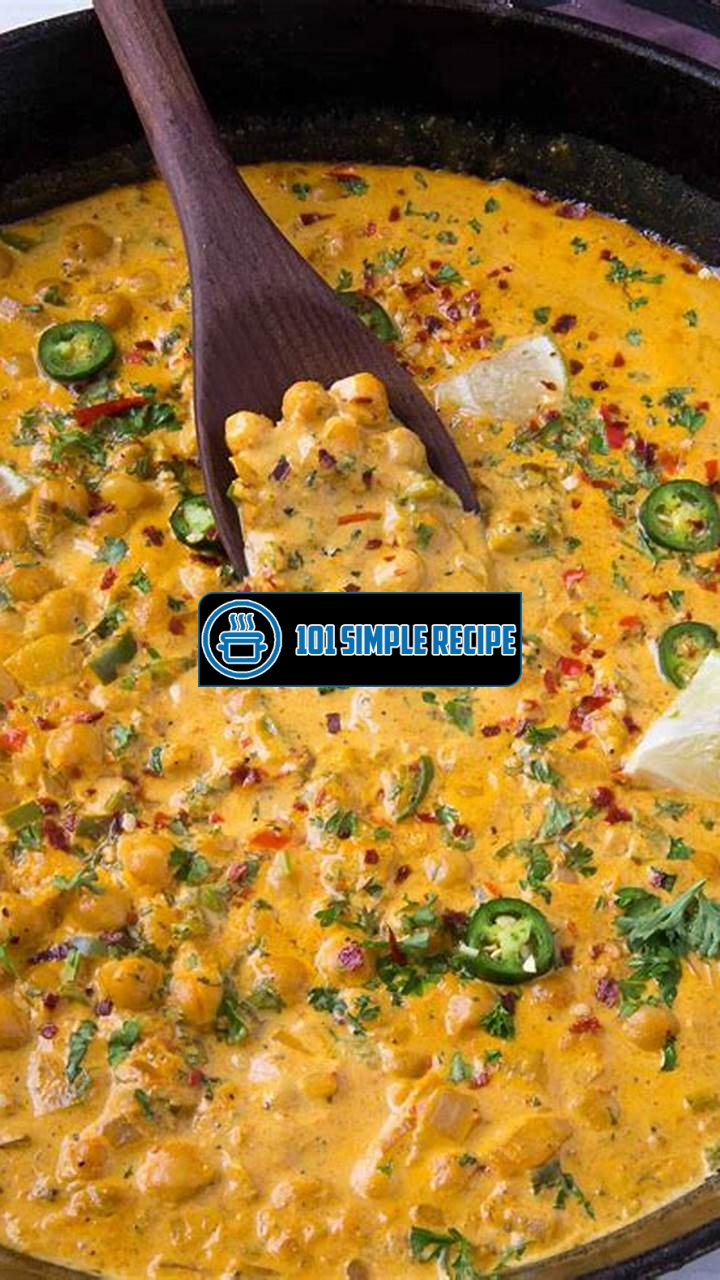Are you looking for a delicious and satisfying vegan dish that is packed with flavor? Look no further than this mouthwatering Chickpea Curry recipe! Whether you’re a seasoned vegan or simply looking to incorporate more plant-based meals into your diet, this flavorful dish is sure to impress. Made with tender chickpeas, aromatic spices, and a rich tomato-based sauce, this curry is a true delight for your taste buds. Plus, it’s quick and easy to prepare, making it a perfect option for busy weeknights. So, get ready to indulge in a bowl of vegan goodness that will leave you craving for more! ✨

Exploring the Versatility of Chickpea Curry
Chickpea curry is a flavorful vegan dish that has gained popularity worldwide. This delicious and nutritious dish has its roots in Indian cuisine, where it is a staple in many households. The versatility of chickpea curry allows for endless variations and adaptations, making it a favorite among vegans and non-vegans alike.
Chickpea curry is known for its rich flavors and unique blend of spices. The combination of aromatic spices such as cumin, coriander, turmeric, and garam masala gives this dish its distinct taste. Each spice adds its own flavor profile, creating a harmonious blend that tantalizes the taste buds.
One of the reasons why chickpea curry is so versatile is because it can be customized according to personal preferences. You can add your favorite vegetables such as spinach, bell peppers, or carrots to enhance the nutritional value of the dish. Additionally, you can adjust the spice level to suit your taste – whether you prefer it mild or fiery hot.
The appeal of chickpea curry extends beyond its delicious flavors. It also offers numerous health benefits that make it a popular choice among health-conscious individuals. Chickpeas, the main ingredient in this dish, are a great source of plant-based protein, fiber, and essential vitamins and minerals.
By incorporating chickpea curry into your diet, you can reap the benefits of a nutritious meal that supports a healthy lifestyle. Chickpeas are known to promote heart health, aid in digestion, and support weight management. They are also a great option for those following a vegan or vegetarian diet, as they provide the necessary protein and nutrients.
When it comes to choosing the right ingredients for chickpea curry, it is important to opt for high-quality and fresh produce. Selecting fresh and seasonal vegetables will enhance the flavors and nutritional value of the dish. Additionally, using organic and locally sourced ingredients can make a positive impact on the environment.
To make a delicious chickpea curry, you will need basic pantry staples such as canned chickpeas, onions, garlic, and tomatoes. These ingredients serve as the foundation for the dish, while spices and herbs can be added to enhance the flavors. Common spices used in chickpea curry include cumin, coriander, turmeric, and garam masala.
Experimenting with different spices and seasonings can take your chickpea curry to the next level. You can also add coconut milk or cream to create a creamy and rich texture. The possibilities are endless, and you can tailor the dish to your own taste and preferences.
In conclusion, chickpea curry is a versatile and flavorful vegan dish that has its roots in Indian cuisine. With its rich flavors and health benefits, it has become a popular choice among individuals who are looking for nutritious and delicious meals. By choosing the right ingredients and experimenting with spices and seasonings, you can create your own unique and delightful version of chickpea curry.
Preparing the Base for Chickpea Curry
Master the art of creating a flavorful and aromatic base for your chickpea curry. This crucial step sets the foundation for a delicious vegan delight that will leave your taste buds craving more. With a few key ingredients and techniques, you can elevate the flavors of your curry to new heights.
Onions, Garlic, and Ginger: The Holy Trinity
When it comes to building the base for your chickpea curry, onions, garlic, and ginger are the essential ingredients that form the holy trinity of flavor. These aromatic ingredients bring a depth and complexity to your curry that cannot be achieved without them.
Start by finely chopping one onion and sautéing it in a large, deep pan with a bit of oil or vegan butter. As the onion becomes translucent and starts to caramelize, add in a generous amount of minced garlic and grated ginger. These two ingredients add a punch of flavor and create a fragrant aroma that will fill your kitchen.
Pro tip: To intensify the flavor, crush the garlic and ginger using a mortar and pestle before adding them to the pan. This helps release their natural oils and enhances their taste.
Blending Spices for the Perfect Curry
The spices you use in your chickpea curry can make or break the dish. By carefully selecting and blending a combination of spices, you can achieve a perfectly balanced flavor profile that will keep you coming back for more.
Some essential spices for a delicious chickpea curry include cumin, coriander, turmeric, and garam masala. These spices add depth and warmth to the dish, while also providing numerous health benefits. Feel free to experiment with the quantities of each spice to suit your personal taste preferences.
️ Spice it up: If you prefer a spicier curry, you can add some red chili powder or flakes. Adjust the amount according to your desired level of heat.
Enhancing the Flavor with Tomatoes or Coconut Milk
Once you have your base of onions, garlic, ginger, and spices, it’s time to enhance the flavor of your chickpea curry even further. Two popular options for adding a rich and creamy element to your dish are tomatoes or coconut milk.
If you prefer a tangy and slightly acidic curry, opt for tomatoes. You can use fresh tomatoes, either chopped or pureed, or even canned tomatoes for convenience. The tomatoes add a burst of freshness and brighten up the flavors of your curry.
On the other hand, if you desire a creamier and more indulgent curry, coconut milk is the perfect addition. The creamy texture and subtle sweetness of coconut milk marry beautifully with the spices, creating a luscious sauce that coats every chickpea.
Creamy twist: For an extra touch of tropical flavor, consider using coconut cream instead of coconut milk. This will give your curry an even richer and more velvety mouthfeel.
By following these tips and techniques, you can create a flavorful and aromatic base for your chickpea curry that will impress both vegans and non-vegans alike. Experiment with different spices, adjust the flavors to your liking, and enjoy the satisfaction of a homemade vegan delight that is as delicious as it is nutritious.
Cooking the Chickpeas to Perfection
When it comes to making a delightful and flavorful vegan chickpea curry, cooking the chickpeas to perfection is of utmost importance. The right cooking techniques will ensure that the chickpeas have a tender and creamy texture in your curry. Here are some tried and tested methods to achieve that:
Soaking and Boiling Chickpeas
One of the most traditional ways to cook chickpeas is to soak them overnight. This helps to soften the beans and reduce their cooking time. To do this, simply place the chickpeas in a bowl, cover them with water, and let them soak for a minimum of 8 hours or overnight. After soaking, drain the water and rinse the chickpeas.
Once the chickpeas are soaked, they can be cooked through boiling. Place the soaked chickpeas in a pot and cover them with fresh water. You can add a pinch of salt or any desired seasoning to enhance the flavor. Bring the water to a boil and then reduce the heat to simmer. Let the chickpeas cook for about 45 minutes to 1 hour, or until they are tender and easily mashed with a fork. Cooking time may vary depending on the size and freshness of the chickpeas, so it’s best to check their texture periodically.
Note: Soaking and boiling chickpeas from scratch is a great way to control the texture and flavor of your curry. It requires a bit more time and effort than using canned chickpeas but is definitely worth it for the best results.
Using Canned Chickpeas for Convenience
For those who are short on time or prefer a more convenient option, using canned chickpeas is a popular choice. Canned chickpeas are pre-cooked and ready to use, saving you the time and effort of soaking and boiling. Simply drain and rinse the canned chickpeas before adding them to your curry.
While using canned chickpeas is convenient, it’s important to note that the texture may not be as tender and creamy as when you cook them from scratch. However, they still provide a delicious addition to your curry with their nutty flavor. If you opt for canned chickpeas, make sure to choose high-quality ones and check for any added salt or preservatives.
Note: Canned chickpeas are a great time-saving option for busy individuals or when you’re in a pinch, but they may not offer the same texture and taste as cooking chickpeas from scratch.
Adding Pre-cooked Chickpeas to Your Curry
If you have leftover cooked chickpeas or prefer to cook them in advance, you can easily incorporate pre-cooked chickpeas into your curry. This method reduces the cooking time and allows you to focus on the other flavorful elements of your dish. Simply add the pre-cooked chickpeas towards the end of the curry-making process and let them simmer in the sauce for a few minutes to soak up the flavors.
Adding pre-cooked chickpeas to your curry is a convenient option that still delivers a delightful taste. The pre-cooked chickpeas will blend well with the spices and other ingredients, creating a harmonious balance of flavors in your dish.
Note: When using pre-cooked chickpeas, be cautious of their tenderness as they may become too soft or mushy if overcooked. Always keep a close eye on their texture and adjust the cooking time accordingly.
In conclusion, understanding various cooking techniques for chickpeas is key to achieving a tender and creamy texture in your vegan chickpea curry. Whether you decide to soak and boil them from scratch, opt for canned chickpeas for convenience, or incorporate pre-cooked chickpeas, each method has its unique benefits. Choose the method that suits your time constraints and desired texture, and enjoy a flavorful vegan delight with your chickpea curry!
If you’re looking for more curry recipes, check out our Weight Loss Recipe or our Cookie in a Mug Recipe. These recipes are delicious and easy to make.
Creating a Balance of Flavors in Your Curry
When it comes to making a delicious chickpea curry, achieving a harmonious balance of flavors is essential. This is what separates an ordinary curry from an extraordinary one. By carefully selecting and combining the right ingredients, you can create a curry that tantalizes your taste buds and leaves you craving for more. Here are the key elements to consider when trying to achieve that perfect balance of flavors in your chickpea curry.
Experimenting with Sweet, Sour, and Spicy Ingredients
Incorporating a combination of sweet, sour, and spicy ingredients is a game-changer when it comes to elevating the flavors in your chickpea curry. Sweetness can be achieved by using ingredients like coconut milk or brown sugar, which adds a subtle and enjoyable sweetness to the dish. For sourness, try using ingredients such as lemon juice or tamarind paste to provide a tangy kick. And of course, don’t forget the heat! By adding spices like chili powder, cumin, or paprika, you can infuse your curry with a delightful spicy kick.
️ Experimenting with the right balance of sweet, sour, and spicy ingredients is key to creating a truly lip-smacking chickpea curry.
The Magic of Garam Masala and Other Spices
No curry is complete without the magic of garam masala and other spices. Garam masala is a blend of ground spices that typically includes coriander, cumin, cardamom, cinnamon, and cloves. Adding this aromatic spice mixture to your chickpea curry brings depth and complexity to the flavors. Additionally, don’t be afraid to experiment with other spices like turmeric, ginger, or fenugreek to add unique and captivating flavors to your dish.
✨ The secret to a truly flavorful chickpea curry lies in the combination of garam masala and other aromatic spices.
Balancing Flavors with Acidic or Tangy Additions
To achieve a well-rounded curry, it’s important to balance the flavors with acidic or tangy additions. Acidic ingredients like tomatoes or vinegar help cut through the richness of the curry, adding a refreshing tanginess. It also helps enhance the overall flavor profile of the dish. Additionally, you can experiment with tangy ingredients like yogurt or lime juice to add a zesty twist to your chickpea curry.
Adding acidic or tangy elements brings a delightful balance and brightness to your chickpea curry.
By incorporating these key elements in your chickpea curry recipe, you can create a flavorful and satisfying vegan delight that will impress even the most discerning palates. Remember, the key is to experiment, trust your taste buds, and have fun while creating your culinary masterpiece!
Perfecting the Cooking Process
When it comes to cooking chickpea curry, there are a few techniques and tips that can help you achieve a delightful dish each time. Whether you’re a seasoned chef or a beginner in the kitchen, these methods will surely elevate your cooking skills to new heights.
Simmering vs. Pressure Cooking: Which is Best?
One crucial decision to make when cooking chickpea curry is whether to use the simmering or pressure cooking method. Both methods have their benefits and it ultimately depends on your preferences and time constraints.
Simmering: Simmering your chickpea curry allows the flavors to meld together slowly over a longer period. This method is great if you have the time to spare and want a deeply flavorful and aromatic curry. It’s perfect for lazy weekends or when you’re looking to savor the cooking process.
Pressure Cooking: On the other hand, pressure cooking can significantly reduce the cooking time of chickpea curry. By utilizing high pressure and steam, the flavors are locked in efficiently, resulting in a tender and tasty curry in a fraction of the time. This method is ideal for busy individuals who want a quick and convenient meal without sacrificing taste.
Ultimately, the choice between simmering and pressure cooking depends on your schedule and preferences. Experiment with both methods to find the one that suits your taste and cooking style best.
Allowing Time for Flavors to Develop
Patience is key when it comes to creating a flavorful chickpea curry.
After cooking your curry, it’s essential to allow enough time for the flavors to develop and intensify. This step is often overlooked, but it can make a significant difference in the taste and overall enjoyment of your dish.
Simply put, the longer you let your curry sit, the more time the spices have to infuse into the dish. This allows for a deeper and more complex flavor profile. Experts recommend letting your chickpea curry rest for at least 30 minutes to an hour before serving. This period gives the flavors a chance to meld together, resulting in a curry that is bursting with harmonious tastes.
Adjusting the Consistency of Your Curry
Want to achieve the perfect consistency for your chickpea curry? It’s easier than you think.
The consistency of your curry can sometimes make or break the overall experience. Whether you prefer a thick and hearty curry or a more soupy texture, there are simple ways to adjust it to your liking.
Thickening: If your curry is too thin for your taste, you can thicken it by using ingredients such as coconut milk, yogurt, or tomato paste. These additions not only provide a creamier texture but also enhance the richness of the flavors.
Thinning: On the other hand, if your curry is too thick, you can easily thin it out by adding vegetable broth, water, or coconut water. Be sure to do this gradually and taste as you go to avoid diluting the flavors too much.
Remember, adjusting the consistency of your chickpea curry is subjective and should be tailored to your personal preferences. Don’t be afraid to experiment and find the perfect consistency that suits your taste buds.
Frequently Asked Questions
Thank you for reading our article on the delicious chickpea curry recipe! Below are some frequently asked questions that may help clarify any doubts you may have:
| No. | Questions | Answers |
|---|---|---|
| 1 | Can I use canned chickpeas instead of dried ones? | Absolutely! Canned chickpeas work just fine in this recipe. Just make sure to rinse and drain them thoroughly before using. |
| 2 | How can I make this recipe spicier? | If you prefer a spicier flavor, feel free to add more chili powder or red pepper flakes to the curry. Adjust the amount according to your taste. |
| 3 | Can I substitute coconut milk with another type of milk? | While coconut milk adds a creamy richness to the curry, you can use other plant-based or dairy milk alternatives if preferred. However, it may alter the flavor slightly. |
| 4 | Is this recipe suitable for vegetarians and vegans? | Absolutely! This chickpea curry recipe is both vegetarian and vegan-friendly, making it a great choice for those with dietary restrictions. |
| 5 | How long can I store the leftovers? | You can store the leftovers in an airtight container in the refrigerator for up to 3 days. Simply reheat before serving. |
| 6 | Can I freeze this curry? | Yes, you can freeze the chickpea curry for up to 3 months. Make sure to cool it down completely before transferring to freezer-safe containers or bags. |
Thanks for Reading and Visit Again!
We hope you enjoyed reading our article on the delectable chickpea curry recipe! Remember to visit our website again for more mouthwatering recipes and culinary inspiration. Don’t forget to share your cooking adventures with us and stay tuned for more delicious updates. Happy cooking!
Jump to Recipe
Chickpea Curry Recipe

Learn how to make a flavorful and aromatic chickpea curry. Perfect for vegetarians and vegans, this dish is packed with protein and spices that will tantalize your taste buds.
- 2 cups dried chickpeas
- 1 onion (chopped)
- 3 garlic cloves (minced)
- 1 tablespoon ginger (grated)
- 2 tomatoes (diced)
- 1 can coconut milk
- 2 tablespoons curry powder
- 1 teaspoon turmeric
- 1/2 teaspoon cumin
- 1/2 teaspoon coriander
- 1/4 teaspoon cayenne pepper
- Salt and pepper to taste
- Fresh cilantro for garnish
- Soak the dried chickpeas in water overnight. Drain and rinse.
- In a large pot, heat some oil and sauté the onions, garlic, and ginger until fragrant.
- Add the tomatoes, coconut milk, and spices to the pot. Stir well to combine.
- Add the soaked chickpeas and enough water to cover them. Bring to a boil, then reduce heat and let simmer for 30 minutes or until chickpeas are tender.
- Season with salt and pepper to taste.
- Garnish with fresh cilantro before serving.






